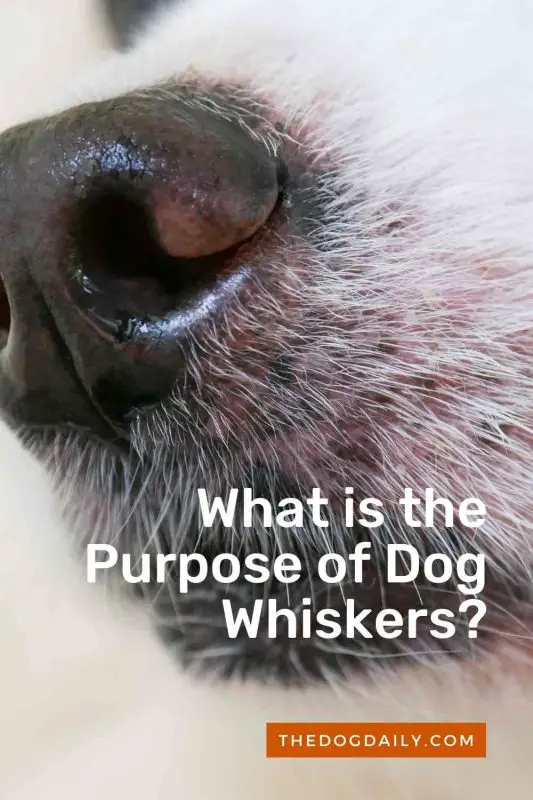What Does a Dog Use Its Whiskers For?
Primarily dog whiskers play two essential roles for dogs; they assist with navigation, and they provide protection.
Navigation:
- The hair follicles at the base of whiskers contain nerves that send sensory information to a dog’s brain. These nerves provide essential information to help the dog evaluate its surroundings. These whiskers are highly sensitive to vibrations found in the air. The dog uses these vibrations to sense nearby objects. A particularly important role as a dog’s vision (especially close up) is nowhere near as strong as its sense of smell.
- Cats sometimes use their whiskers for feeling their way around places during the night, but cats see better in the dark than dogs do. Dogs often find themselves in situations where the ability to sense movement is helpful, and at times, that ability is even more important than being able to see. That’s where a dog’s whiskers come into play. They can function as a guide when, for example, your dog walks down the hallway towards the water bowl at 2 a.m.
- “For dogs who like to dig and tunnel in the dark, it’s good for them to know where their face is located, how far it is from a wall,” says Dr. Foil. “That’s why the vibrissae are there; they let them know where their whole face is.” She adds, “Dogs can then tell what’s happening all around their face in a tunnel or going after a mouse in the dark.”
When Threatened:
- Whiskers are also used when dogs express their emotions. When dogs are scared or feel threatened, they will point their whiskers forward, seemingly a defense strategy. When a dog is asleep, so are its whiskers, but when a dog is active, the whiskers are too!
Eye Protection:
- As well as having an essential navigational role, whiskers can also provide some protection for a dog’s eyes. The whiskers above a dog’s eyes offer protection to the eyes, much like eyebrows do for human eyes.
Do Dog Whiskers Require Any Care?
Whiskers are great from the standpoint of dog owners because they require zero maintenance. All you need to do is leave them alone, but that isn’t as easy as you might think, given how often you probably pet your dog’s head. Your dog won’t like it if you touch or otherwise move the vibrissae. “They are highly innervated (supplied with nerves), so if they touch something or if the wind blows on them, there will be feedback to the dog’s brain,” says Debra Eldredge, DVM, of Vernon, New York, author of the Dog Owner’s Home Veterinary Handbook. If such sensory input were not valuable to your dog, the evolutionary process would have eliminated these motion-sensing hairs from its anatomy. Usually, you might only fuss with whiskers on a dog if you plan to enter your pet in a dog show competition. You would have four options: surgical removal, plucking, trimming, or just leaving the whiskers alone.
Surgical Removal
Surgical removal is the most severe option, and many veterinarians do not recommend it. Like declawing cats, you would deprive your dog of something used to improve its senses, potentially eliminating one way that it takes in information about its surroundings and environment.
Plucking
Although plucking offers a more temporary solution than surgical removal, Dr. Foil advises would-be dog manicurists to quell their plucking temptations. “Don’t ever pluck (the vibrissae),” she says, “as that is very painful compared to plucking other hairs. They will bleed and bleed, and that’s why they’re also called blood hairs.” Remember that the “beauty marks” the hairs grow in are mounds of nerves, so plucking anything out of that mound is painful.
Trimming
Similar to shaping your eyebrows, the vibrissae can be trimmed, except with more pain involved. Such manicuring doesn’t occur with all breeds or in every dog of a given breed at shows. But some people will still clip or trim the hairs down for a neater appearance. Your dog won’t enjoy having vibrissae trimmed, but at least trimming can be done without inflicting pain on your dog the way plucking would. If you choose this option, be careful and go slowly. “Most dogs don’t even like having their whiskers touched,” warns Dr. Eldredge.
Doing Nothing
The do-nothing approach is the best of all, at least from your dog’s perspective and your veterinarian. However, you and your pet might have to give up the show’s gold ribbon in favor of what you might call “a more natural look.”
People tend to think of facial marks or moles as a blemish, but you should see your dog’s whiskery features as beauty marks. Think of them as more tactile than Marilyn Monroe’s or Cindy Crawford’s famous beauty spots, yet no less becoming. Your dog’s beauty mark is attractive and highly functional, and no blemish can claim that.
Article written by Author: Phyllis DeGioia and The Dog Daily Expert

